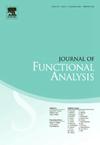Strong almost finiteness
IF 1.6
2区 数学
Q1 MATHEMATICS
引用次数: 0
Abstract
A countable, bounded degree graph is almost finite if it has a tiling with isomorphic copies of finitely many Følner sets, and we call it strongly almost finite, if the tiling can be randomized so that the probability that a vertex is on the boundary of a tile is uniformly small. We give various equivalents for strong almost finiteness. In particular, we prove that Property A together with the Følner property is equivalent to strong almost finiteness. Using these characterizations, we show that graphs of subexponential growth and Schreier graphs of amenable groups are always strongly almost finite, generalizing the celebrated result of Downarowicz, Huczek and Zhang about amenable Cayley graphs, based on graph theoretic rather than group theoretic principles. We give various equivalents to Property A for graphs, and show that if a sequence of graphs of Property A (in a uniform sense) converges to a graph G in the neighborhood distance (a purely combinatorial analogue of the classical Benjamini-Schramm distance), then their Laplacian spectra converge to the Laplacian spectrum of G in the Hausdorff distance. We apply the previous theory to construct a new and rich class of classifiable -algebras. Namely, we show that for any minimal strong almost finite graph G there are naturally associated simple, nuclear, stably finite -algebras that are classifiable by their Elliott invariants.
强几乎有限
一个可数的有界度图是几乎有限的,如果它有一个具有有限多个Følner集合的同构副本的平铺,我们称之为强几乎有限,如果平铺可以随机化,使得顶点在平铺边界上的概率一致小。我们给出了强几乎有限的各种等价形式。特别地,我们证明了性质A与Følner性质是等价于强几乎有限的。利用这些刻画,我们证明了次指数增长图和可调群的Schreier图总是强几乎有限的,推广了Downarowicz, Huczek和Zhang关于可调Cayley图的著名结果,基于图论而不是群论原理。我们给出了图的性质A的各种等价,并证明了如果性质A的图序列(在一致意义上)在邻域距离(经典benjami - schramm距离的纯粹组合模拟)收敛于图G,则它们的拉普拉斯谱在Hausdorff距离收敛于G的拉普拉斯谱。我们运用之前的理论构造了一个新的丰富的可分类C -代数。也就是说,我们证明了对于任何最小的强几乎有限图G,存在自然关联的简单的,核的,稳定有限的C -代数,这些代数可以通过它们的艾略特不变量分类。
本文章由计算机程序翻译,如有差异,请以英文原文为准。
求助全文
约1分钟内获得全文
求助全文
来源期刊
CiteScore
3.20
自引率
5.90%
发文量
271
审稿时长
7.5 months
期刊介绍:
The Journal of Functional Analysis presents original research papers in all scientific disciplines in which modern functional analysis plays a basic role. Articles by scientists in a variety of interdisciplinary areas are published.
Research Areas Include:
• Significant applications of functional analysis, including those to other areas of mathematics
• New developments in functional analysis
• Contributions to important problems in and challenges to functional analysis

 求助内容:
求助内容: 应助结果提醒方式:
应助结果提醒方式:


